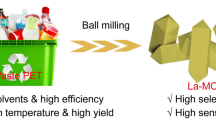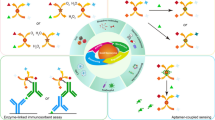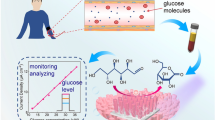Abstract
A metal organic framework obtained from cerium(III) and trimesic acid was pyrolyzed to obtain a novel nanostructure referred to as CeO2/C nanowires. The experimental parameters temperature, precursor and gas atmosphere were optimized. The nanowires show good dispersion and a large number of oxygen vacancies, and this leads to excellent peroxidase-like activity. The nanowires are stable at pH values between 2 and 10, and in the 4–80 °C temperature range. The peroxidase-mimicking activity was exploited in a sensitive colorimetric method for determination of H2O2 by using 3,3′,5,5′-tetramethylbenzidine as the chromogenic substrate. The absorbance at 652 nm increases linearly in the 0.5 to 100 μM H2O2 concentration range. If glucose oxidase is added to a solution containing glucose, H2O2 will be enzymatically produced. This was exploited to design a new method for determination of glucose. The optical response is linear in the 1–100 μM glucose concentration range, and the detection limit is 0.69 μM (at S/N = 3). The method was successfully applied to the determination of glucose in serum samples.

CeO2/C nanowires prepared by Ce-MOF pyrolysis show peroxidase-like activity and are able to catalyze the oxidation of tetramethylbenzidine (TMB) by H2O2. This was applied to glucose oxidase-based colorimetruc determination of glucose in human sera







Similar content being viewed by others
References
Wei H, Wang E (2013) Nanomaterials with enzyme-like characteristics (nanozymes): next-generation artificial enzymes. Chem Soc Rev 42:6060–6093
Lin Y, Ren J, Qu X (2014) Catalytically active nanomaterials: a promising candidate for artificial enzymes. Acc Chem Res 47:1097–1105
Gao L, Zhuang J, Nie L, Zhang J, Zhang Y, Gu N, Wang T, Feng J, Yang D, Perrett S, Yan X (2007) Intrinsic peroxidase-like activity of ferromagnetic nanoparticles. Nat Nanotechnol 2:577–583
Wei H, Wang E (2008) Fe3O4 magnetic nanoparticles as peroxidase mimetics and their applications in H2O2 and glucose detection. Anal Chem 80:2250–2254
Korsvik C, Patil S, Seal S, Self WT (2007) Superoxide dismutase mimetic properties exhibited by vacancy engineered ceria nanoparticles. Chem Commun 1056–1058
Wang X, Guo W, Hu Y, Wu J, Wei H (2016) Nanozymes: next wave of artificial enzymes. Springer, New York
Tian Z, Li J, Zhang Z, Gao W, Zhou X, Qu Y (2015) Highly sensitive and robust peroxidase-like activity of porous nanorods of ceria and their application for breast cancer detection. Biomaterials 59:116–124
Artiglia L, Agnoli S, Paganini MC, Cattelan M, Granozzi G (2014) TiO2@CeOx core-shell nanoparticles as artificial enzymes with peroxidase-like activity. ACS Appl Mater Interfaces 6:20130–20136
Zhao H, Dong Y, Jiang P, Wang G, Zhang J (2015) Highly dispersed CeO2 on TiO2 nanotube: a synergistic nanocomposite with superior peroxidase-like activity. ACS Appl Mater Interfaces 7:6451–6461
Hua G, Zhang L, Fei G, Fang M (2012) Enhanced catalytic activity induced by defects in mesoporous ceria nanotubes. J Mater Chem 22:6851–6855
Babu S, Thanneeru R, Inerbaev T, Day R, Masunov AE, Schulte A, Seal S (2009) Dopant-mediated oxygen vacancy tuning in ceria nanoparticles. Nanotechnology 20:085713
Jampaiah D, Reddy TS, Kandjani AE, Selvakannan PR, Sabri YM, Coyle VE, Shukla R, Bhargava SK (2016) Fe-doped CeO2 nanorods for enhanced peroxidase-like activity and their application towards glucose detection. J Mater Chem B 4:3874–3885
Jampaiah D, Reddy TS, Coyle VE, Nafady A, Bhargava SK (2017) Co3O4@CeO2 hybrid flower-like microspheres: a strong synergistic peroxidase-mimicking artificial enzyme with high sensitivity for glucose detection. J Mater Chem B 5:720–730
Chen L, Si Z, Wu X, Weng D (2014) DRIFT study of CuO-CeO2-TiO2 mixed oxides for NOx reduction with NH3 at low temperatures. ACS Appl Mater Interfaces 6:8134–8145
Gao W, Zhang Z, Li J, Ma Y, Qu Y (2015) Surface engineering on CeO2 nanorods by chemical redox etching and their enhanced catalytic activity for CO oxidation. Nanoscale 7:11686–11691
Xia W, Mahmood A, Zou R, Xu Q (2015) Metal-organic frameworks and their derived nanostructures for electrochemical energy storage and conversion. Energy Environ Sci 8:1837–1866
Kim TK, Lee KJ, Cheon JY, Lee JH, Joo SH, Moon HR (2013) Nanoporous metal oxides with tunable and nanocrystalline frameworks via conversion of metal-organic frameworks. J Am Chem Soc 135:8940–8946
Cho W, Park S, Oh M (2011) Coordination polymer nanorods of Fe-MIL-88B and their utilization for selective preparation of hematite and magnetite nanorods. Chem Commun 47:4138–4140
Xia W, Zou R, An L, Xia D, Guo S (2015) A metal-organic framework route to in situ encapsulation of Co@Co3O4@C core@bishell nanoparticles into a highly ordered porous carbon matrix for oxygen reduction. Energy Environ Sci 8:568–576
Fang G, Zhou J, Cai Y, Liu S, Tan X, Pan A, Liang S (2017) Metal-organic framework-templated two-dimensional hybrid bimetallic metal oxides with enhanced lithium/sodium storage capability. J Mater Chem A 5:13983–13993
Xu W, Xie W, Wang Y (2017) Co3O4-x-carbon@Fe2-yCoyO3 heterostructural hollow polyhedrons for the oxygen evolution reaction. ACS Appl Mater Interfaces 9:28642–28649
Zhu C, Ding T, Gao W, Ma K, Tian Y, Li X (2017) CuO/CeO2 catalysts synthesized from Ce-UiO-66 metal-organic framework for preferential CO oxidation. Int J Hydrog Energy 42:17457–17465
Peng B, Cui J, Wang Y, Liu J, Zheng H, Jin L, Zhang X, Zhang Y, Wu Y (2018) CeO2−x/C/rGO nanocomposites derived from Ce-MOF and graphene oxide as a robust platform for highly sensitive uric acid detection. Nanoscale 10:1939–1945
Xiong Y, Chen S, Ye F, Su L, Zhang C, Shen S, Zhao S (2015) Synthesis of a mixed valence state Ce-MOF as an oxidase mimetic for the colorimetric detection of biothiols. Chem Commun 51:4635–4638
Pastor-Villegas J, Durán-Valle CJ, Valenzuela-Calahorro C, Gómez-Serrano V (1998) Organic chemical structure and structural shrinkage of chars prepared from rockrose. Carbon 36:1251–1256
Chen X, Chen X, Yu E, Cai S, Jia H, Chen J, Liang P (2018) In situ pyrolysis of Ce-MOF to prepare CeO2 catalyst with obviously improved catalytic performance for toluene combustion. Chem Eng J 344:469–479
Du C, Gao X, Cheng C, Zhuang Z, Li X, Chen W (2018) Metal organic framework for the fabrication of mutually interacted Pt-CeO2-C ternary nanostructure: advanced electrocatalyst for oxygen reduction reaction. Electrochim Acta 266:348–356
Sun L, Ding Y, Jiang Y, Liu Q (2017) Montmorillonite-loaded ceria nanocomposites with superior peroxidase-like activity for rapid colorimetric detection of H2O2. Sensors Actuators B Chem 239:848–856
Liu Q, Yang Y, Lv X, Ding Y, Zhang Y, Jing J, Xu C (2017) One-step synthesis of uniform nanoparticles of porphyrin functionalized ceria with promising peroxidase mimetics for H2O2 and glucose colorimetric detection. Sensors Actuators B Chem 240:726–734
Jiao X, Song H, Zhao H, Bai W, Zhang L, Lv Y (2012) Well-redispersed ceria nanoparticles: promising peroxidase mimetics for H2O2 and glucose detection. Anal Methods 4:3261–3267
Li Z, Yang X, Yang Y, Tan Y, He Y, Liu M, Liu X, Yuan Q (2018) Peroxidase-mimicking nanozyme with enhanced activity and high stability based on metal-support interaction. Chem Eur J 24:409–415
Shi W, Wang Q, Long Y, Cheng Z, Chen S, Zheng H, Huang Y (2011) Carbon nanodots as peroxidase mimetics and their applications to glucose detection. Chem Commun 47:6695–6697
Hu L, Yuan Y, Zhang L, Zhao J, Majeed S, Xu G (2013) Copper nanoclusters as peroxidase mimetics and their applications to H2O2 and glucose detection. Anal Chim Acta 762:83–86
Lian J, Liu P, Jin C, Shi Z, Luo X, Liu Q (2019) Perylene diimide-functionalized CeO2 nanocomposite as a peroxidase mimic for colorimetric determination of hydrogen peroxide and glutathione. Microchim Acta 186:332
Wang N, Duan J, Shi W, Zhai X, Guan F, Yang L, Hou B (2018) A 3-dimensional C/CeO2 hollow nanostructure framework as a peroxidase mimetic, and its application to the colorimetric determination of hydrogen peroxide. Microchim Acta 185:417
Lin Z, Xiao Y, Yin Y, Hu W, Liu W, Yang H (2014) Facile synthesis of enzyme-inorganic hybrid nanoflowers and its application as a colorimetric platform for visual detection of hydrogen peroxide and phenol. ACS Appl Mater Interfaces 6:10775–10782
Cao X, Li Y, Zhang Z, Yu J, Qian J, Liu S (2012) Catalytic activity and stability of glucose oxidase/horseradish peroxidase co-confined in macroporous silica foam. Analyst 137:5785–5791
Acknowledgements
The financial support of the research was provided by the Natural Science Foundation of China (51678485) and the Research Funding Project of Yangtze Normal University (No. 011160030).
Author information
Authors and Affiliations
Corresponding author
Ethics declarations
The author(s) declare that they have no competing interests.
Additional information
Publisher’s note
Springer Nature remains neutral with regard to jurisdictional claims in published maps and institutional affiliations.
Electronic supplementary material
ESM 1
(DOC 3305 kb)
Rights and permissions
About this article
Cite this article
Dong, W., Huang, Y. CeO2/C nanowire derived from a cerium(III) based organic framework as a peroxidase mimic for colorimetric sensing of hydrogen peroxide and for enzymatic sensing of glucose. Microchim Acta 187, 11 (2020). https://doi.org/10.1007/s00604-019-4032-2
Received:
Accepted:
Published:
DOI: https://doi.org/10.1007/s00604-019-4032-2




